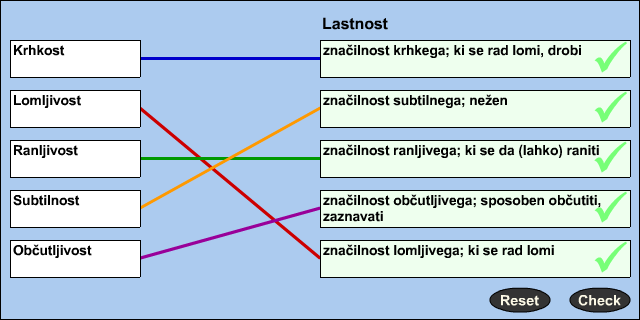Introduction to the notion of fragility in architecture and design

Fragility?
The term, fragility, can suggest different things to different people in a general context but in the context of architecture and design, the notion of fragility can take on a special meaning with a range of connotations.
In these activities you will consider the meaning and connotations of fragility in English in the context of architecture and design. You will also review terms and their meanings in Slovene connected with the theme of fragility.
Activity 1: Connotations of the notion of fragility in English
In this activity you are going to explore various aspects of meaning related to the term, fragility, as used in architecture and design contexts.

Instruction
Read these five short texts which refer to different aspects of fragility as used in architecture and design contexts. Complete each text by selecting the appropriate aspect of fragility from the dropdown list. Then read the feedback.
1. The elegant and structure of Norman Foster's glass roof in the British Museum can be compared to an almost invisible, intricate, and yet, extraordinarily beautiful spider's web.
2. Glass as a construction material is often perceived to be an extremely fragile and material but it can withstand a significant load, especially if it is reinforced correctly with additional materials.
3. Some urban spaces are to sudden change such as the major addition of new elements, expansion programmes and buildings.
4. A intervention in the urban landscape can, at the same time, radiate respect towards an existing urban setting but this in no way has to be mundane or predictable - the ideal solution is however, usually hard to find and a lot of thought and effort needs to be put into it.
5. Traditional historic centres contain buildings, forms and geometry which have settled down over centuries of use, and are mixed with contemporary transient structures, such as market stalls, temporary commercial operations and opportunistic vendors, all of which contribute to the life of the street. These images are quite spaces, which can easily be disrupted through interventions that are not adapted to scale or to the corresponding social structures.
Activity 2: Reviewing Slovene terms associated with fragility
In this activity you are going to review the connotations of Slovene terms connected with the theme of fragility by matching them with possible English counterparts, and then with further explanation in Slovene.

Instruction
Study the list of Slovene terms reflecting different dimensions of fragility and match them with the corresponding terms and explanations in English by clicking on the Slovene term on the left and then clicking on the corresponding English explanation on the right. Match the Slovene terms with their explanations in Slovene in the same way. Then read the feedback and listen to the recordings.
© Archi21 Project Consortium: Ecole Nationale Supérieure d'Architecture Paris-Malaquais, Open University, University of Ljubljana, Aalborg Universitet, University of Southampton and eLanguages. Image courtesy of angestalt (Flickr).
This work is licensed under a Creative Commons Attribution-NonCommercial-NoDerivs CC BY-NC-ND Licence. 

